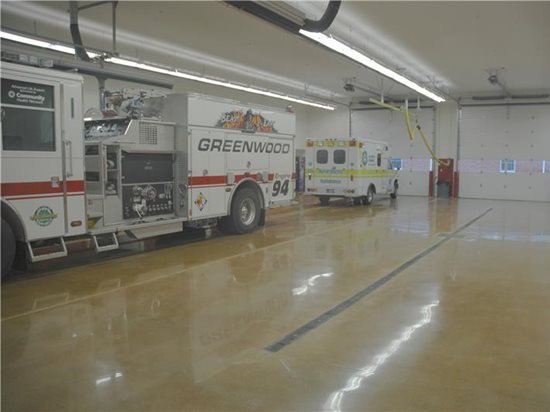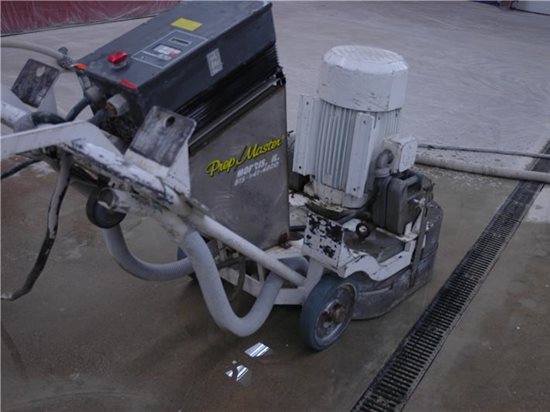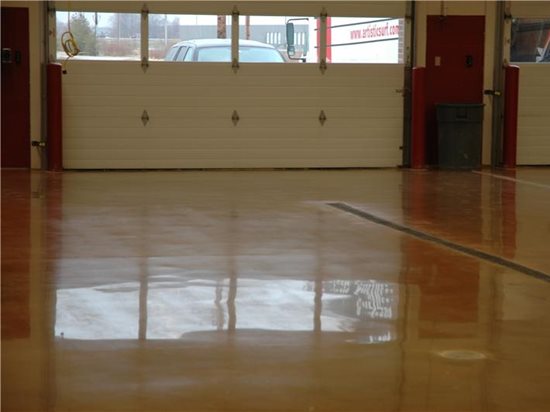- Polished Concrete Information
- Polished Concrete Pictures
- What is Polished Concrete
- Polished Concrete Cost
- Design Ideas for Polished Concrete
- Polished Concrete Maintenance
- Common Questions about Polished Concrete
- Can All Concrete be Polished?
- Comparison Chart: Polished concrete versus other flooring materials
- What are Polished Overlays?
- Polishing Products and Equipment: An overview of basic equipment and supplies needed
- Related Information
- Information About: Concrete Floors
- Concrete Contractors: Find Concrete Polishing Products and Suppliers
- Design Ideas: Polished Concrete Info
Polishing Brings Out the Shine in Concrete Fire Station Floor
Concrete polishing and staining revives a grungy, dull floor and gives it a low-maintenance sheen
The fire station floor after polishing and staining not only looks like new, it also has the added benefits of high light reflectivity, low maintenance and good skid resistance.
The fire station owned by the City of Greenwood, Indiana, was just over a year old, but already the concrete flooring in the engine room and adjoining locker room was scuffed up and dull—and in serious need of a rehab. To the rescue came Kerry Calvert of Artistic Surfaces, Indianapolis. Armed with an arsenal of surface preparation and diamond grinding equipment—and a first-aid kit of sealer, grout, densifier and stain—he successfully restored the gleam and gloss to these ailing floors.
The existing 5,000-square-feet of concrete flooring had been coated with a sealer that was not wearing well under the traffic of the big fire trucks and bustling fire fighters on call. That prompted fire lieutenant John Dean to visit The Concrete Network website and research the restoration options.
"The fire station personnel were unhappy with the way the floor looked," says Calvert. "The sealer was scuffed up, and the floor looked very dull and industrial, while the rest of the facility is very nicely done. John became aware of polished concrete through The Concrete Network and contacted us through the website."
Concrete flooring in other areas of the fire station had been coated with an epoxy, but a high slab moisture content had caused problems with the bonding of the coating, so the station was reluctant to put an epoxy on the engine room floor. "I met with John and explained the benefits of polished concrete, including low maintenance, longevity and no risk of damage from a high moisture content," explains Calvert. "John along with the fire chief and the other station lieutenants came to look at our shop floor, which is polished concrete, and they liked the look."
In addition to polishing the floor, Calvert's crew applied an acid stain, using a new procedure that eliminated the mottling effect common with acid staining and gave the floor a uniform color.
Project Challenges
Calvert explains that this polishing job was tougher than most because the slabs were sloped for drainage and had two long floor drains requiring laborious edge work.
"Edges are an Achilles' heel on all polishing jobs, and particularly so on this project because the edges along the floor drains were poorly troweled," he says. "We had to run all of our metal-bond diamond grinding discs at a slow rate, averaging about 150 square feet per hour per grit level. Each grit was run north, south, east and west across the floor in order to ensure full, even coverage."
In addition, the existing floor had small voids in areas where the concrete was porous and not well compacted and where aggregate at the surface had come loose. Calvert tried out a latex-based grout from Husqvarna specifically formulated to fill small voids and pinholes during the polishing process. "This was the first time we had used this product. It did an excellent job of filling in the small pores in the concrete surface, so that when you look at the floor from an angle, it looks like glass," says Calvert.
Surface prep and polishing procedures
Prior to starting the grinding operations, Artistic Surfaces filled the control joints with a semi-rigid epoxy joint filler from Metzger/McGuire. The two-component 100%-solids epoxy is formulated to fill and protect joints in concrete floors subject to heavy traffic loads, and it also helps protect the joint walls from the edge chipping that occurs when metal-bond diamonds are used during polishing.
"We then started grinding the surface with 40-grit metal-bond diamond tooling, and followed this with an 80 grit," says Calvert, describing the series of steps his crew followed to restore and polish the floor. "Next, we used the latex grout to wet grind the floor with a 150-grit metal bond. This filled in the pores in the concrete so we had a very tight surface from which to proceed. We then went to a 50-grit resin-bond diamond, damp mopping in front of the machines to have a slightly wet cut. This was followed by a 200-grit resin bond, which was run dry. We then stained and densified the floor, and burnished the floor after the densification. The floor was then polished up to 800 grit."
As a final step to increase the water repellency and stain resistance of the floor, the crew applied Husqvarna's Hiperguard penetrating, impregnating sealer. "The firemen were concerned about the slipperiness of the floor. The Hiperguard sealer increases the slip resistance and does not leave a film on the surface that can be scratched," says Calvert.
New staining technique
 A close-up of the finished floor, colored with a brick-red acid stain and protected with a penetrating
A close-up of the finished floor, colored with a brick-red acid stain and protected with a penetratingArtistic Surfaces also used a new application procedure for the acid stain that essentially eliminated the etching effect that acid stains leave on most concrete surfaces, which can make a polished floor look dingy when viewed in highly reflective lighting.
"We slightly diluted the acid stain, using a 1-to-3 ratio of water to acid stain, and sprayed the solution on the floor, immediately spreading it with a microfiber mop," says Calvert. "Not letting the stain pool helps quite a bit in eliminating the severe burning and etching that can take away from the shine and clarity of a polished floor. It also takes away from the dramatic mottling effect that some people want to see. But in this case, the firemen wanted more of a flat, consistent color."
Artistic Surfaces completed the engine room floor makeover in December 2008, and reports that the fire station crew is pleased with the results. "One lieutenant said that when he first saw the completed floor, he was concerned because it looked so glassy he was sure it would be slippery," says Calvert. "But they have found it not to be slippery at all, unlike the epoxy-coated floors they have in the interior hallways and laundry areas."
Artistic Surfaces
Indianapolis, IN 46236
Equipment and Products Used on this Project
- Grinding and polishing machines
-
Prep/Master 3030, from Substrate Technology (www.substratetechnology.com)
HTC 800, from HTC Inc. (www.htc-america.com)
- Latex grouting system
-
GM 3000, from Husqvarna Construction Products (http://us.husqvarnacp.com)
- Joint filler
-
MM-80P from Metzger/McGuire (www.metzgermcguire.com)
- Densifier
-
Certi-Shine Clear, from Vexcon Chemicals (www.vexcon.com)
- Penetrating sealer
-
Hiperguard, from Husqvarna (http://us.husqvarnacp.com)
- Acid stain
-
Stone Tone Concrete Floor Stain in English Red, from Kemiko (www.kemiko.com)






